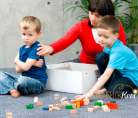Helping children recognize and manage their emotions is an essential part of healthy development. One of the most effective ways to support this growth is through regular emotional check-ins. These moments of connection help children understand what they feel, why they feel that way, and how to express their emotions in a healthy manner.
Emotional check-ins can be as simple as asking, “How are you feeling today?” or inviting children to choose a feeling from a chart. The goal is to create a safe and open space where children feel comfortable sharing. When children are encouraged to talk about their feelings regularly, they develop stronger emotional awareness and communication skills.
These check-ins also allow adults to notice changes in a child’s mood or behavior early on. If a child seems sad, frustrated, or withdrawn, it opens an opportunity to provide support before the emotions grow overwhelming. It can also strengthen the bond between the adult and child, building trust and emotional security.
In classrooms, emotional check-ins can be part of the daily routine. Whether through morning meetings, journaling, or quiet one-on-one conversations, these practices help create a supportive learning environment. At home, bedtime or mealtime are great opportunities to ask how a child is feeling and listen with patience and care.
By making emotional check-ins a consistent habit, we show children that their feelings matter. This not only boosts their confidence but also lays the foundation for emotional intelligence, empathy, and resilience throughout their lives.


